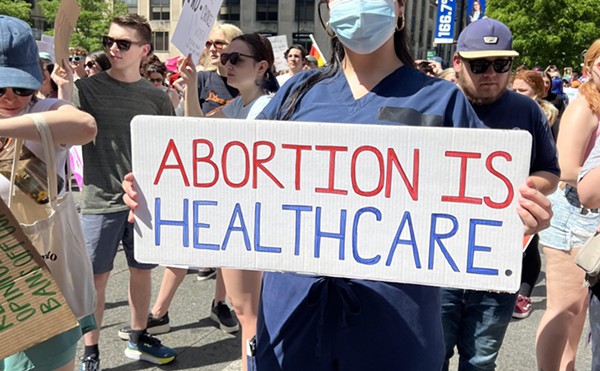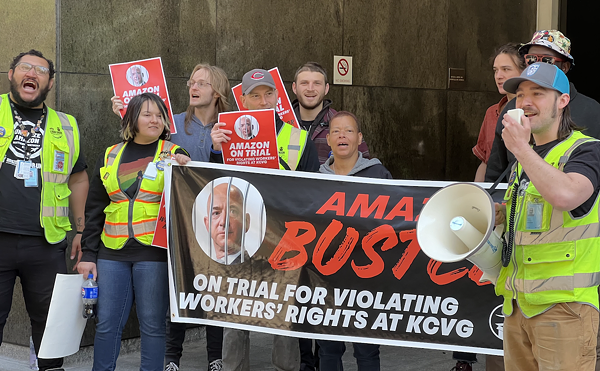|
Take a walk down Cincinnati's Fifth Street one of these days, and you're bound to be amazed. With the skywalks dropped and the clutter scraped away, Fountain Square already looks more inviting and more — dare I even suggest it? — European.
After 40 years, our city's heart finally reverts to pedestrian scale.
With lots of plans on the drawing boards, together with rising interest in downtown living, we should reflect on the kind of city we want to be.
One Cincinnati-sized city that's cracked the code for downtown success is Portland, Ore. Remarkably similar in physical layout to Cincinnati/Northern Kentucky, Portland is nationally recognized as a "best practices" laboratory for good urban planning and design. Even its city vehicles trumpet Chicago-like civic confidence: "Portland — The City That Works."
There's a new Safeway supermarket near downtown Portland that's topped with expensive apartments. The development is called Museum Place, and planners encouraged some clever innovations in its design.
For example, Portland's transportation department re-striped 10th Avenue with angled parking spaces right in front of the store.
Doing so affected a driving lane, but it sure made it easier to buy things at Safeway.
The traffic engineers also yielded another lane for the Portland Streetcar, which passes the store every 13 minutes and connects it to a broad swath of lively neighborhoods in and around downtown. Quite a few Safeway customers take the streetcar to get their groceries and so shop more frequently, more locally and less painfully.
Most regions logically use their transportation funds to move people from Point A to some distant Point B as quickly as possible. Portland does a lot of that too, except it spends some of its roadway money so people can get everyday stuff right where they live.
Portland's elected officials are redesigning neighborhoods for the people who live and work there rather than as raceways for commuters, hence the angled parking at the Safeway and the Portland Streetcar.
It's good business, too. The Safeway store is a top performer in the firm's Portland region, and the Museum Place apartments are 98 percent leased at rents up to $2,400 per month plus utilities.
Portland is turning the urban transportation model on its head. As gas prices rise and congestion increases, leaders there are betting Portlanders will increasingly value access — being able to fulfill their needs close to home — just as much as they now value mobility.
Thus Portland has slightly altered the terms of trade under which cities labor in today's auto-centric world. They've done this by making cars a little less important in the scheme of things, and they're really just getting started.
You'll find the streetcar and a MAX light rail train in only one-third of Portland's neighborhoods, and only one of the city's four rail lines is more than eight years old. But in several of Portland's old and new neighborhoods, a family can live well with fewer cars — or perhaps with no car at all.
And this is where our story becomes relevant to Cincinnati.
Making the numbers work
Summon an image of all the new apartment buildings underway in downtown and uptown Cincinnati, plus the Kentucky riverfront. Now multiply by 10. That's the recent volume of residential construction underway in central Portland compared to Cincinnati, cities of similar size and population.
Now consider the quality of our newest buildings, and multiply by about 1.2. That's a very subjective judgment about how much better Portland's newest buildings are compared to Cincinnati's.
Portland's economy isn't exactly booming. There's only one Fortune 500 firm in all of Oregon; Cincinnati/Northern Kentucky has 10. Though Oregon has no sales tax, Portland employers pay a steep 9 percent tax on their payrolls, which naturally retards job creation. One result is that Portland's unemployment rate has been among the highest in the nation for the last few years, but it's recently been declining.
And yet they're building like crazy in Portland. Here's what's going on, greatly simplified for illustration.
Consider the Cincinnati builder's formula for constructing a downtown apartment project. He figures he has to supply about two parking spaces per dwelling unit. If the project requires an underground garage, this means an investment of $50,000 just to build the two parking spaces for each apartment. Figuring out the parking is one reason why Cincinnati's central riverfront Banks development — once projected to wrap up this year — has yet to get out of the ground.
Because Portland is such a transit-rich, walkable community, an apartment builder there might get by with providing only one parking space per unit. Thus each apartment's parking costs $25,000 less to build. That's the supply side of the equation.
Now consider the demand side, the calculus of a couple purchasing the condo. Instead of spending the $8,000 per year that Cincinnati families spend on their cars and trucks, the Portland family might spend half as much because it can get by with only one car. Based on interest rates of 6 percent, the $4,000 they save each year can be leveraged into $65,000 more condo — perhaps an extra bedroom.
Put it all together, and the equation pencils out like this: The Portland developer can lower the condo's price by $25,000 and still make the same margin, and the purchasers with only one car can now afford an additional $65,000 worth of space. So the gap between the developer's pro-forma and his customers' budget gets closed by $90,000, a big difference on a condo selling for $300,000 or $400,000.
But there's more.
Over time, the couple buying the condo will enjoy lower maintenance fees because there's less parking to maintain. Since they're able to buy more space from the get-go, our couple can stay in their home longer before they outgrow it. They might remain in the neighborhood after their children are born.
That foregone second car would have been worthless in its 10th year while the condo rises in value over the same period. Assuming that Portland's housing appreciates by just 3 percent a year, the extra $65,000 of condo investment would be worth $87,000 in 10 years. And that doesn't even count the tax advantages of owning a home — via deducting interest on your mortgage payments — that you don't get by owning a car.
Since our hypothetical couple shops closer to home, their neighborhood business district gains customers who formerly drove somewhere else. Now stores and restaurants can succeed because of an expanded customer base instead of relying on government handouts. So the taxpayers benefit, too.
There's safety in numbers. People now walk around the neighborhood more often, so the streets seem safer and there's less graffiti and littering.
And people are healthier. In fact, Oregon is the only state where obesity rates aren't increasing. Since the Portland region comprises more than half of Oregon's total population, good urban design probably has something to do with this.
Sadly, Ohio, Kentucky and Indiana top the list of states where obesity is increasing the fastest. Winston Churchill said it most eloquently when contemplating the rebuilding of bombed-out London after World War II: "We shape our dwellings, and afterwards they shape us."
Cities for city people
Well, you say, that's a nice theory, but prove it. Prove that what Portland is doing is making things better there.
Since Portland began its experiment in urban livability around 1970, its population has grown from 382,000 to 529,000 residents, including some gains from suburban annexation in the 1980s. During this same period, Cincinnati's population declined from 452,000 to 331,000.
People are moving to Portland — many of them right out of school, many without secure jobs — simply because they want to live there. Clearly, that region is setting itself up to attract some of the best brains of the future.
Joseph Cortright, an economist researching the migration of youthful talent in America, found that only Seattle and Denver, two regions that are also making huge investments in rail, have been more successful than Portland at growing their populations of college-educated 25- to 34-year-olds within three miles of their center cities.
By the way, Portland isn't necessarily content with being Portland. These days some Portlanders wish that it were more like Vancouver, BC. Cities on the move always know they can do better.
To be sure, Portland has its share of problems. Locals constantly fret over the decline of their city's schools and the loss of high-paying manufacturing jobs. Oregon's median family income trails Ohio's and is way below that of neighboring California and Washington.
And it's not like Portland enjoys some kind of paradise climate like much of the West Coast. It can be cloudy and rainy from November through May, and it's 100 miles from the Pacific Ocean. Take away Portland's mountains, and Cincinnati is arguably a prettier city with a stronger architectural legacy.
Defenders of the status quo don't want Portland's 35-year experiment in urban livability to succeed more than it already has. Road warriors and sprawl apologists will tell you Portland's smarter growth and transit investments are a house of cards and, because of all this new urbanism nonsense, you can't even drive in Portland anymore. These claims are false.
Travel + Leisure Magazine annually surveys its readers on the subject of "America's Favorite Cities." For the last two years, Portland's visitors and residents both ranked the city first in the "Getting Around" category, mostly because of its excellent public transportation, biking and walkability. But Portland also got high marks for ease of driving and for its cleanliness, parks and interesting neighborhoods. Plus — get this — for "peacefulness."
So what does this mean to us in Cincinnati with our dumb growth, no rail and none of the tools Portland used to dissolve the funk of its 1970s forest industry collapse? The answer is, until we get more thoughtful leadership around here, we'll have to make do with what we have.
And the truth is, we do have some things going for us already. For example, consider one reason people give for not wanting to live downtown: "We need a movie theater!"
Well, that's one view. Here's another: Some weekend afternoon, park downtown and walk to a movie at Newport-on-the-Levee. Stay and have dinner. End the evening with a walk back over the river at sunset. It's better. You'll see.
Prospective downtown residents fret over the absence of a large grocery store. Funny, none of my downtown neighbors has ever said that. They know better.
Sure, a full-service grocery store would be nice some day. But with our continuously improving Findlay Market plus Avril's, Silverglades and Cianciolo, you can make it work right now.
The point is that Cincinnatians need to think differently if we're to achieve sustainable momentum in our center city. Downtown living will never compute if it has to conform to the specifications of suburbia.
It seems counterintuitive, but if the prerequisites for downtown success are mall-like parking, multiplex cinemas and single-purpose destinations, we'll never have a real downtown. Ironically, every so-called improvement aimed to please the highway economy digs downtown into a deeper hole and moves it even further away from the pedestrian-friendly city centers we all love to visit.
In truth, Cincinnatians need to shed their comfort zones and begin to savor the latent richness and ease of downtown living.
Few things in life are perfect — being able to walk to work is surely one of them. So next time there's a giant snowstorm, imagine you could be leisurely walking home kicking up snow clouds along the way and then lighting your fireplace as streams of tail lights crawl toward uncertain arrivals. You could imagine that you're beating the system, such as it is.
If you now live downtown, you know you have.
JOHN SCHNEIDER chairs the Alliance for Regional Transit, which leads groups of Cincinnatians to Portland several times a year to tour the light rail and streetcar systems there. He is a property investor who lives downtown and occasionally writes about transportation issues.
No Money, Little Support for Cincinnati
On Feb. 8 President Bush recommended to Congress more than $1.5 billion in funding for up to 28 new or expanding major transit projects "aimed at increasing mobility and easing congestion in urban and suburban communities." Greater Cincinnati representatives in Congress — particularly Steve Chabot — consistently have blocked such projects here and yet are likely to pass Bush's budget, sending public funds elsewhere.
Among the transit projects to be funded in the federal government's Fiscal Year 2007 budget are:
· Baltimore: Upgrading 9.4 miles of its existing light rail transit system.
· Charlotte: Building a 9.6-mile light rail transit line, the beginning of a brand new system.
· Dallas: Adding a 20.9-mile light rail transit line extension to its existing system.
· Denver: Adding 19.1-mile and 12.1-mile light rail transit line extensions to its existing system.
· Los Angeles: Adding a 5.9-mile light rail transit line to its existing system.
· Northern New Jersey: Adding a 5.1-mile light rail transit line extension to its existing system.
· Phoenix: Building a 19.6-mile light rail transit line, the beginning of a brand new system.
· Pittsburgh: Adding a 1.5-mile light rail transit line extension to its existing system.
· Portland: Adding a 5.8-mile light rail transit line extension to its existing system.
· San Diego: Adding 5.9-mile and 3.4-mile light rail transit line extensions to its existing system.
· Seattle: Building a 13.9-mile light rail transit line, the beginning of a brand new system.
A complete list of recommended transit projects is available online at www.fta.dot.gov.
See a City that Works
The Alliance for Regional Transit's next trip to Portland, Ore., is Feb. 24, a one-day tour of the city and its exceptional public transit system.
The tour will focus entirely on the center city, never straying more than three miles from Pioneer Square: two new-from-scratch downtown neighborhoods, the area around Portland State University, the zoo, parks and other civic amenities. Attendees will compare and contrast what they see to similar elements in Cincinnati's downtown and uptown.
The trip will focus on the Portland Streetcar, seen by some as a more conservative way to introduce rail transit to Cincinnatians. Attendees will get a close-up look at the latest streetcar construction project, a half-mile extension connecting downtown with Portland's new South Waterfront District.
The Alliance for Regional Transit has arranged for speakers to give perspective on what's going on there:
· Joseph Cortright is a Portland-based economist who studies the migration of youthful talent and is the author of The Young and Restless in a Knowledge Economy. During lunch at the Oregon Zoo, he'll discuss how cities are reshaping their downtowns and close-in neighborhoods to attract college-educated 25- to 34-year-olds who can live wherever they want.
· Robert Liberty is a Portland Metro Council member, elected in 2004. He's an attorney with 25 years experience in land use planning issues, including serving as a staff attorney and executive director for 1,000 Friends of Oregon, the nation's oldest statewide smart growth advocacy organization.
The fee for attending is $104, which covers the cost of the tour, lunch and dinner. Attendees are on their own for airfare and hotel costs. For more information, contact [email protected].





